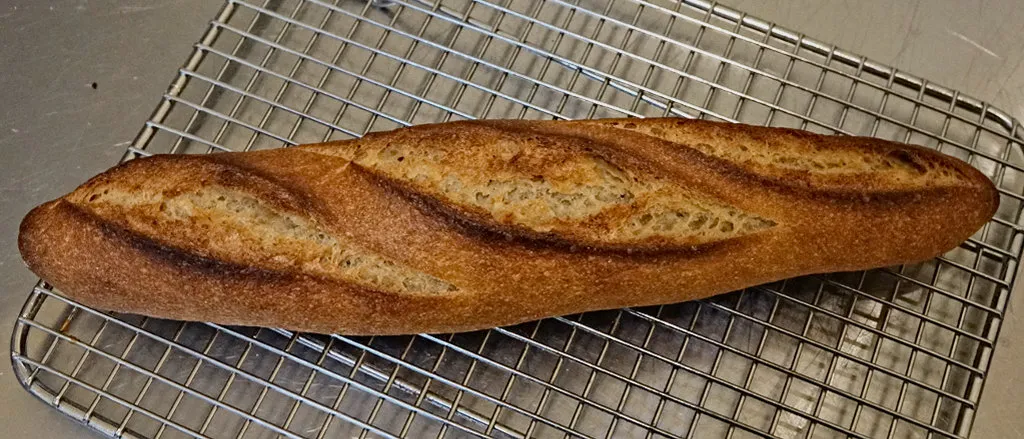
I recently posted about making baguettes using a simulation of T55 flour. I'm in the middle of trying to improve my baguettes, and fooling with different flours has been part of it: https://www.thefreshloaf.com/node/74270/simulating-t55-flour
I also posted about using a whole wheat atta flour - made by Sujata - and how well it worked in an 80%-20% atta - KA bread flour - https://www.thefreshloaf.com/node/74152/atta-flour-yes-you-can-continued
Yesterday I got a different brand of WW atta, one of the apparently well-known brands: Aashirwaad Chakki Atta flour. I had a thought of trying it out in a baguette, just out of curiosity. I didn't think it would be all that suitable, but why not try? And it would give me some more baguette practice. I was going to bake bread with the 80-20 atta mix today anyway, so I increased the dough size by 1/3, so I could use the extra for a single baguette.
The dough had 25% starter, 1.8% salt, and an overall hydration of 76%. I worked some extra water in during kneading and S&F, and I think I should have added even a little more. The dough made with this bag of atta was not quite as delightful to work with as the bag of Sujata I posted about before, and the surface seemed a little dry and unwilling to stretch as much, but the dough was still good to handle and seemed to develop a good gluten structure easily.
Fermentation went much faster than expected. After only four hours the bulk had doubled and I put into the refrigerator. The next morning the dough had bulked up to probably triple the original size. I had planned to use the dough in an earlier stage of development, but there it was.
I cut off a 200g piece for the baguette and put the rest back in the refrigerator. After a light preform and a 10-minute rest I shaped the baguette. It seemed like overkill to set up the linen couche for only one loaf so I just let it rise free-standing and covered on a sheet of parchment paper. After 45 minutes I uncovered the loaf and removed the rest of the dough from the refrigerator.
I scored the baguette after 10 more minutes, and baked it with initial steam at 425 deg F for a total of 26 minutes.
After putting the baguette into the oven, I preformed the batarde, then shaped it and let it proof for 40 minutes, Then I uncovered the loaf and let it sit for 10 more minutes. I baked with initial steam and turned the oven temperature setting down to 300 deg F for around 14 minutes. Then I reset to 425 deg F and baked for a total of 42 minutes.
All right, enough talk, here are the pictures: 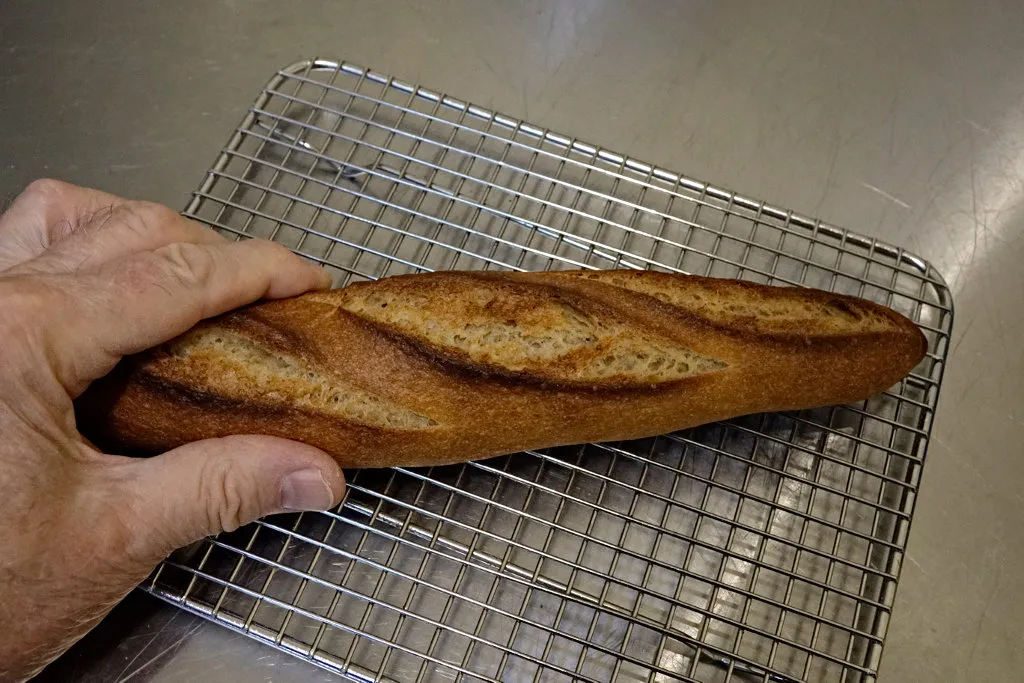
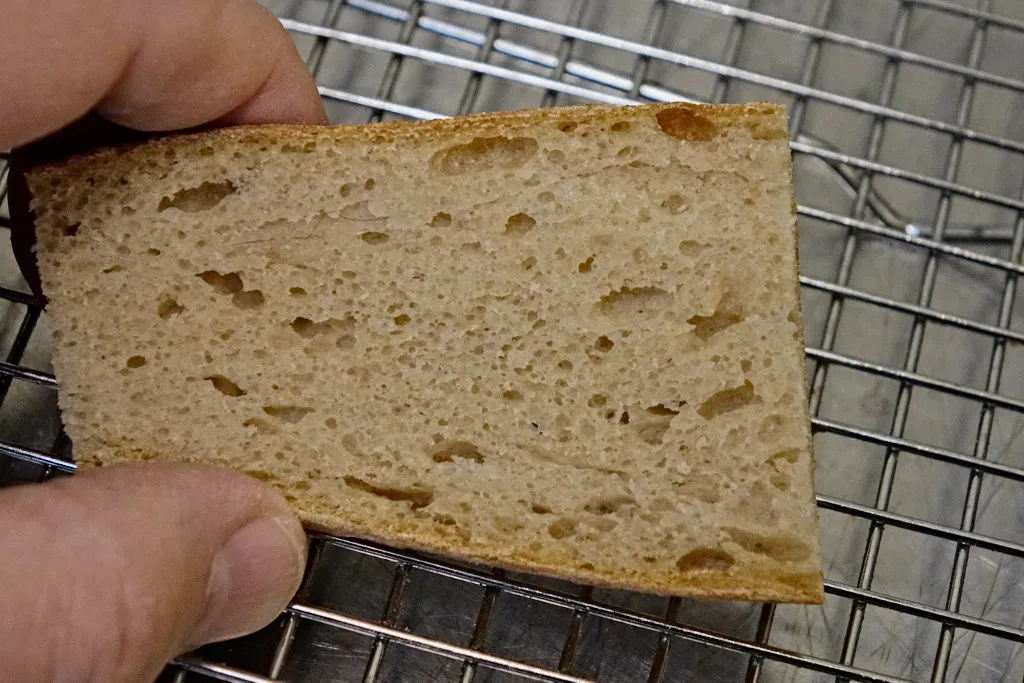
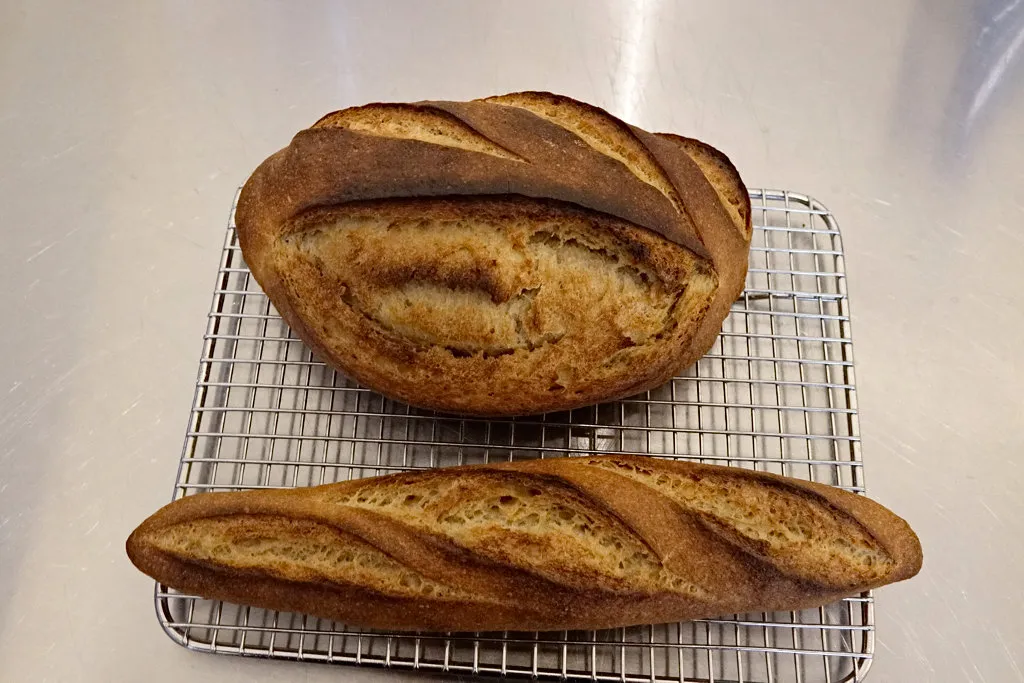
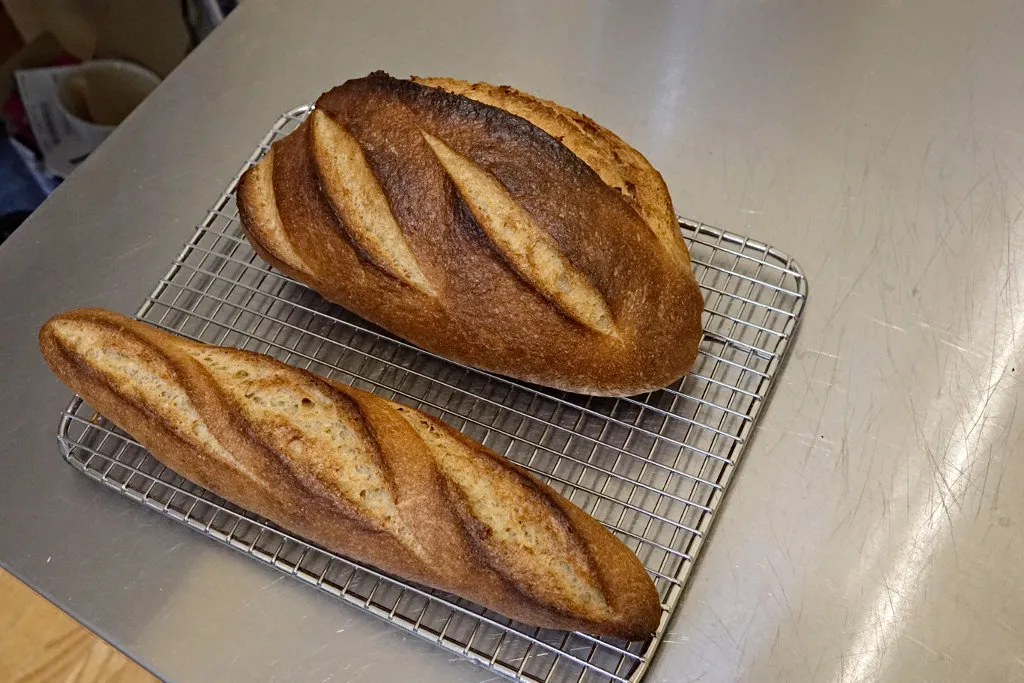
You can see extremely good expansion in the oven. So what was the baguette like? It looks like a baguette, and it tastes quite good. But it's lacking two qualities I think a baguette should have. The crust doesn't have that flaky crispness, where shards of crust spring off and you hear them shattering as you bite through it. The crust is good, it's just not quite what I'm seeking for a baguette.
Second, the crumb isn't as open as I am aiming for, I don't insist on the crazy large cavities that some people can get but this loaf was more uniform and tighter, and had less of a fluffy feel, than I would like.
OTOH the taste is very fine. It isn't sour but it has a kind of savoriness that made my mouth water a bit as I chewed it. It's much like my earlier bread made from the Sujata brand of atta flour.
I think the high percentage of WW, combined with the high level of damaged starch that we always read that atta flour has, retain extra water and doesn't let the crust quite develop that shattering quality. I think that more baking would produced a burnt crust, not a baguette-style one. If you weren't thinking "baguette" you would probably be very happy with the loaf. Handling the dough and shaping the baguette form were easy.
All in all, a fun baking day here in Winchester.
TomP
I wouldn’t have thought to try atta flour in a baguette. It probably militates against an open crumb but it’s interesting to see what happens.
That size baguette would make a great sub sandwich, by the way.
Paul
Thanks, Paul. Yes, it is good for a sub. I've been halving them across and making half-size subs, or just toasting and buttering the split halves. I thought that baguettes were a little larger, not counting the length, of course. But mine seem to always come out about 2 - 2 1/4 inch across, or 5.1 to 5.7 cm. That's right in the range of "traditional" baguettes, which is usually claimed to be 5 - 6 cm across in my readings. Anyway, I've come to like this size, partly because I can have a sub without feeling overstuffed with bread.
Appealing golden colour to both breads, and an interesting read, thanks Tom.
The taste sounds pretty good too. I might called it a demi-baguette though (unless you have big hands) :-)
I'm a bit behind on reading TFL, but from what I recall, you were sifting store bought rather than home milled? In any case, it activated an old memory of reading a post by someone on reddit a long time ago regarding home milled flours and T number equivalence - this comment where he said #40 screen for a home made T85 (integrale) approximation.
Of course, it is time to treat yourself and buy some real french flour, and to treat all of us when we read about your experience with it, good or bad....
Right, I don't have a mill.
About getting some "real" T55, I might try it once I find a source. I've noticed that many vendors provide flours they *say* are T55 but turn out to be milled here in the US, and some people have written that they aren't really the same.
Definitely demi. I could probably get a few more inches on the length. This one started at 12 but shrank to 10 during proofing. Longer than that and I'd need a bigger oven.
Actually, I always thought that T55 was a very white flour (thought not as white as a T45 of course). I'm sure I've read that this was so much the case, that French bakers started to get a bad press for using excessively refined flour and this is why many of them switched to T65.
I haven't got any T55, but I do have T65 and it still makes a pretty white loaf (assuming roller milled version).
I'm sure your baggies are delicious TomP, but I'm just wondering if they are somewhat less white than French T55 would make?
Lance
Lance, the last time I saw a baguette in person in France was 1959 ... and I don't remember many details. You wrote about it being very white, yet I've read often that T55 is "creamy" rather than white. I'm probably not the person to ask, and maybe those people were really looking at T65 anyway, who knows?
I've also read that there has been a trend, over the last decade or two, for people to want their bread less white. Bakers have responded to that (I've read) and so current breads are not as snowy white as they used to be.
Baguettes are very much a work in progress for me (as you can see). Do you have a recommendation for a good French flour I can order in the US? T55 or T65, either would be interesting.
TomP
Tom, check with Trailrunner (Caroline). She's a big fan of French T65 and I'm sure she will point you in the right direction.
The most common brand in the UK is Foricher, but I don't know if it makes it over your way at a sensible price.
Lance
Thanks, Lance, I've just PM'd her.
You've triggered a (covid) memory for me of a discussion here.
Jon, I quite often sift the output from my Mockmill. I think the Reddit post is "about right", but my thoughts are that a #50 will get you closer to T85; I think #40 will get you something inbetween T85 and T110.
Lance